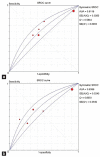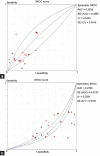Predictive value of FSH, testicular volume, and histopathological findings for the sperm retrieval rate of microdissection TESE in nonobstructive azoospermia: a meta-analysis
- PMID: 28361811
- PMCID: PMC5753551
- DOI: 10.4103/aja.aja_5_17
Predictive value of FSH, testicular volume, and histopathological findings for the sperm retrieval rate of microdissection TESE in nonobstructive azoospermia: a meta-analysis
Abstract
We performed this meta-analysis to evaluate the predictive value of different parameters in the sperm retrieval rate (SRR) of microdissection testicular sperm extraction (TESE) in patients with nonobstructive azoospermia (NOA). All relevant studies were searched in PubMed, Web of Science, EMBASE, Cochrane Library, and EBSCO. We chose three parameters to perform the meta-analysis: follicle-stimulating hormone (FSH), testicular volume, and testicular histopathological findings which included three patterns: hypospermatogenesis (HS), maturation arrest (MA), and Sertoli-cell-only syndrome (SCOS). If there was a threshold effect, only the area under the summary receiver operating characteristic curve (AUSROC) was calculated. Otherwise, the pooled sensitivity, specificity, positive likelihood ratio (PLR), negative likelihood ratio (NLR), and the diagnostic odds ratio (DOR) were also calculated. Twenty-one articles were included in our study finally. There was a threshold effect among studies investigating FSH and SCOS. The AUSROCs of FSH, testicular volume, HS, MA, and SCOS were 0.6119, 0.6389, 0.6758, 0.5535, and 0.2763, respectively. The DORs of testicular volume, HS, and MA were 1.98, 16.49, and 1.26, respectively. The sensitivities of them were 0.80, 0.30, and 0.27, while the specificities of them were 0.35, 0.98, and 0.76, respectively. The PLRs of them were 1.49, 10.63, and 1.15, respectively. And NLRs were 0.73, 0.72, and 0.95, respectively. All the investigated factors in our study had limited predictive value. However, the histopathological findings were helpful to some extent. Most patients with HS could get sperm by microdissection TESE.
Figures





Similar articles
-
Testicular histology may predict the successful sperm retrieval in patients with non-obstructive azoospermia undergoing conventional TESE: a diagnostic accuracy study.J Assist Reprod Genet. 2017 Jan;34(1):149-154. doi: 10.1007/s10815-016-0812-3. Epub 2016 Sep 21. J Assist Reprod Genet. 2017. PMID: 27655389 Free PMC article.
-
Predictors of successful salvage microdissection testicular sperm extraction (mTESE) after failed initial TESE in patients with non-obstructive azoospermia: A systematic review and meta-analysis.Andrology. 2024 Jan;12(1):30-44. doi: 10.1111/andr.13448. Epub 2023 May 22. Andrology. 2024. PMID: 37172416
-
Predictors for successful sperm retrieval of salvage microdissection testicular sperm extraction (TESE) following failed TESE in nonobstructive azoospermia patients.Andrologia. 2017 May;49(4). doi: 10.1111/and.12642. Epub 2016 Jul 21. Andrologia. 2017. PMID: 27444399
-
Outcome of microdissection TESE compared with conventional TESE in non-obstructive azoospermia: a systematic review.Andrology. 2014 Jan;2(1):20-4. doi: 10.1111/j.2047-2927.2013.00148.x. Epub 2013 Nov 6. Andrology. 2014. PMID: 24193894
-
Microdissection testicular sperm extraction (micro-TESE): Predictive value of preoperative hormonal levels and pathology in non-obstructive azoospermia.Kaohsiung J Med Sci. 2018 Feb;34(2):103-108. doi: 10.1016/j.kjms.2017.08.010. Epub 2017 Sep 19. Kaohsiung J Med Sci. 2018. PMID: 29413225 Free PMC article.
Cited by
-
The expression of Beclin-1 in testicular tissues of non-obstructive azoospermia patients and its predictive value in sperm retrieval rate.Transl Androl Urol. 2021 Aug;10(8):3267-3274. doi: 10.21037/tau-21-320. Transl Androl Urol. 2021. PMID: 34532251 Free PMC article.
-
Factors influencing the sperm retrieval rate of microdissection testicular sperm extraction in patients with nonmosaic Klinefelter syndrome.Asian J Androl. 2023 Nov 1;25(6):704-707. doi: 10.4103/aja2022124. Epub 2023 Mar 31. Asian J Androl. 2023. PMID: 37005982 Free PMC article.
-
Development of a predictive nomogram for testicular sperm extraction outcomes in patients with non-obstructive azoospermia using testicular volume, follicle-stimulating hormone levels, and testosterone levels as key parameters.Transl Androl Urol. 2025 Jan 31;14(1):112-123. doi: 10.21037/tau-24-531. Epub 2025 Jan 22. Transl Androl Urol. 2025. PMID: 39974810 Free PMC article.
-
Two Decades from the Introduction of Microdissection Testicular Sperm Extraction: How This Surgical Technique Has Improved the Management of NOA.J Clin Med. 2021 Mar 29;10(7):1374. doi: 10.3390/jcm10071374. J Clin Med. 2021. PMID: 33805395 Free PMC article. Review.
-
Evaluation of the Utility of Seminal Plasma Resistin and Leptin in Predicting Successful Surgical Sperm Retrieval in Men with Non-Obstructive Azoospermia.J Reprod Infertil. 2023 Apr-Jun;24(2):108-116. doi: 10.18502/jri.v24i2.12496. J Reprod Infertil. 2023. PMID: 37547577 Free PMC article.
References
-
- Su LM, Palermo GD, Goldstein M, Veeck LL, Rosenwaks Z, et al. Testicular sperm extraction with intracytoplasmic sperm injection for nonobstructive azoospermia: testicular histology can predict success of sperm retrieval. J Urol. 1999;161:112–6. - PubMed
-
- Turunc T, Gul U, Haydardedeoglu B, Bal N, Kuzgunbay B, et al. Conventional testicular sperm extraction combined with the microdissection technique in nonobstructive azoospermic patients: a prospective comparative study. Fertil Steril. 2010;94:2157–60. - PubMed
-
- Schlegel PN. Nonobstructive azoospermia: a revolutionary surgical approach and results. Semin Reprod Med. 2009;27:165–70. - PubMed
-
- Devroey P, Liu J, Nagy Z, Goossens A, Tournaye H, et al. Pregnancies after testicular sperm extraction and intracytoplasmic sperm injection in non-obstructive azoospermia. Hum Reprod. 1995;10:1457–60. - PubMed
-
- Schlegel PN. Testicular sperm extraction: microdissection improves sperm yield with minimal tissue excision. Hum Reprod. 1999;14:131–5. - PubMed
Publication types
MeSH terms
Substances
Supplementary concepts
LinkOut - more resources
Full Text Sources
Other Literature Sources
Medical

